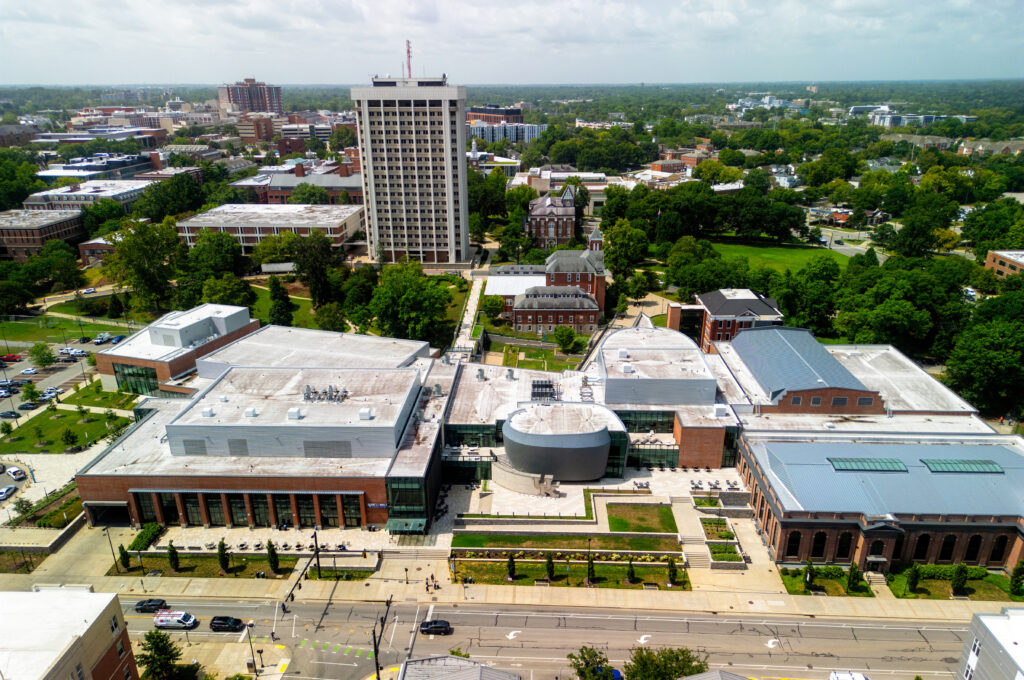The UK Gatton Student center was reimagined with sustainability as a focus. This renovation and expansion has been awarded LEED Silver by the U.S. Green Building Council. It embodies many of the sustainability priorities of the University of Kentucky.
What is LEED?
LEED, or Leadership in Energy and Environmental Design, provided a framework to create healthy, highly efficient, and cost-saving green buildings throughout the world. LEED certification is a globally recognized symbol of sustainability achieved by earning credits across several eco-friendly building categories. The UK Student Center is rated LEED Silver, earning credits in all major LEED categories.
Building Materials
The selection of building materials for UK’s Gatton Student Center prioritized re-use and recycled content. New materials were regionally and sustainably sourced with a focus on indoor air quality.
The building integrates the existing Alumni Gym, built in 1923, and the original Student Union designed by Ernst Johnson in 1938. This decision preserved an important part of the university’s architectural history, significantly reduced the amount of new material required, and prevented tons of material from landfill disposal.
Trees that had to be removed for the project were used to craft some of the tables in the building and were fabricated at the UK Robinson Center for Appalachian Resource Sustainability. The wood on the Social Stair is also reclaimed regional oak horse farm fencing.
Landscaping and Site Features
Because the new Gatton Student Center was built on the same site as the previous building, the new building could use existing infrastructures and preserve the surrounding green spaces. The limestone and marble used in the site walls are native, natural stones from quarries in Kentucky.
A permeable paving system used in the South Plaza and East Parking Lots recharges storm water into the soil and reduced potential downstream flooding.
Many of the plants surrounding the building are native species that require less supplemental irrigation, fewer fertilizers, and generally less labor to maintain. Several upper-level patios also include green-roof landscaping.
Connection sidewalks and bike lanes along with 193 bicycle racks around the building make biking and walking convenient, sustainable choice for anyone coming to the Student Center.
Parking spaces closest to the building entrance are designated for fuel-efficient and low-emissions vehicles.
UK Dining
In the UK Gatton Student Center, Champions Kitchen has integrated the sustainable dining practices that are used in dining facilities across campus.
With trayless dining, UK Dining conserves energy and water, minimizes single-use plastic waste, and reduces the amount of cleaning chemicals entering the waste stream. The fryer oil used within Champions Kitchen is recovered by an organization that converts it into biodiesel.
Thanks to a strong partnership with Champions Kitchens at University of Kentucky, a student-run organization that recovers leftover food, UK Dining is able to provide food for meals that are given to individuals facing food insecurity or hunger.
Champions Kitchen is one of several locations on campus offering Green to Go reusable containers. These to-go boxes offer a meal for busy students and staff to carry out, while also reducing single-waste.
UK Dining purchases almost $2 million annually of food from local farmers and businesses across the state of Kentucky. Look for the Local Impact logo around the dining hall to find ingredients purchases from Kentucky producers.
Energy Efficiency
The design of the UK Gatton Student Center focused on efforts, both large and small, to reduce the energy demand from the building’s heating, cooling, and lighting systems.
New exterior walls and roofs have high insulation values to reduce heat gain and loss. This reduces stress on the building’s heating and cooling systems, saving energy.
Horizontal and vertical sunscreens reduce direct sunlight and glare inside the building. The abundant, non-direct daylighting lowers the need for powered lights during the daytime in many areas of the building. Like many buildings on campus, most of the lights in the building have occupancy sensors and dimmers, turning off lights when no one is in the room or dimming to emit less light.
Water Efficiency
Buildings consume large volumes of water for basic user functions, maintenance, and landscaping. By designing a more water efficient building, not only is the amount of water reduced by also the amount of energy required to heat or cool that water.
A portion of the Gatton Student Center roof collects rainwater into a 20,000 gallon underground tank to provide irrigation for the plants in the roof gardens and other landscape terraces.
Landfill Diversion
During the demolition and construction phases of the Gatton Student Center, waste was diligently managed to reduce the amount of material sent to the landfill. During construction, concrete and steel from demolition were separated to be recycled and reused. The steel was sent to a recycling center while the concrete was crushed on site for construction fill.
Not to mention, there are recycling bins throughout the building, making it easy to incorporate recycling into your daily routine. Water bottle fill stations are located at every water fountain to make it more convenient to use a refillable water bottle, and reduce plastic waste.
Sustainability at UK
Sustainability has taken off at the University of Kentucky over the last decade and is now ingrained in a broad set of initiatives, programs, and guiding documents. The UK Sustainability Strategic Plan will guide the integration of sustainability with campus operations over the next five years and include the University’s commitment to cut greenhouse gas emissions by 25% by 2025.

